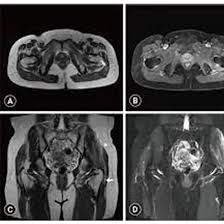Book an Appointment
MRI Screening of Gluteal Region
Medifyhome has collaborated with the best pathology laboratories that are NABL and NABH certified and follow ISO safety guidelines to provide the best MRI Screening Of Bilateral Legs at an affordable price for needy individuals. The muscles and tendons in this area, hip and buttocks, contain the hip bones, and nerves important in overall body movement and stability. The gluteal region is one and a significant muscle group, therefore; it can be affected by numerous pathological processes such as traumatic injury and degenerative changes, inflammatory diseases and neurological disorders.
MRI is especially useful in scanning for soft tissue injuries, long-term ailments, and diseases that cannot be seen on images gotten from regular X-Rays or CT scans. Gluteal region MRI is a helpful examination in diagnosing muscle strain, tendon tear, bursitis, nerve impingement, soft tissue mass, joint pathology and many others. The fact that these conditions can be recognized early makes it easier to manage them through conservative care, rehabilitation or in the unlikely circumstances that a surgical management is called for. To schedule an appointment for MRI Screening Of Gluteal Region, simply contact Medifyhome or call our customer care at +919100907036 or +919100907622 for more details and queries.
Indications for MRI Screening of the Gluteal Region
MRI scanning of the gluteal region is always recommended for diagnosing a number of musculoskeletal, soft tissue, and neurological conditions. The detailed imaging capability makes MRI an excellent choice to detect and evaluate various abnormalities in the gluteal area. Below are common indications for MRI screening of the gluteal region:
- Soft Tissue Injuries
Gluteal Muscle Strains and Tears: MRI is ideal for the diagnosis of muscle tears, strains, or contusions of the gluteus maximus, gluteus medius, and gluteus minimus muscles. It can help to stage the injury and thus to devise a rehabilitation program.
Tendon Injuries: MRI helps diagnose inflammation, degeneration, or rupture of tendons, especially the gluteus medius tendon that may be commonly implicated in overuse or injury.
- Sciatic Nerve Problems
- This radiological investigation is useful when piriformis syndrome presents as a cause of potentially painful, numb, and tingling sensations in the back of the buttock because often the pain radiates downwards into the leg.
- Whenever there is suspicion of Sciatica caused by a ruptured or prolapsed disc, spinal stenosis or impaction of the nerve roots with or without the rupture, tear and disruption, in turn, causing the disc itself and surrounding tissues to become unstable, MRI can evaluate that area.
- Nerve Entrapment or Irritation: It can identify other types of nerve compression or entrapment in the gluteal area, which often results in chronic pain and muscle weakness.
- Bursitis and Inflammation
Trochanteric Bursitis: An inflamed trochanteric bursa, which is next to the hip and the buttock area, is easily diagnosed with MRI imaging as the same determines the collection or irritation of fluid within the bursa.
Ischial Bursitis: Also this condition, ischial bursitis inflammation around the pelvis and the buttock area may also be diagnosed and evaluated on MRI when patients are assessed with chronic pain in this region.
- Gluteal Masses or Tumors
- Benign and Malignant Masses: MRI proves quite helpful in soft tissue mass like lipomas or simple cysts and perhaps malignancy. It yields pictures where a mass could be localized by size and exact locations so that one is appropriately helped by further diagnostic evaluation to find the proper type of therapy.
- Ganglion Cysts: Gluteal region may often include fluid-filled cyst, especially where the cyst presents but must be imaged and, for the presence thereof with effect on other tissue being seen.
- Hip Labral Tears
Although the labral tear primarily involves the hip joint, it may extend and can involve the gluteal muscles with resultant pain, thus the need for good MRI studies, preferably after the use of contrast.
Common Pathologies Detected by MRI in the Gluteal Region
MRI scanning of the gluteal region offers an excellent image of soft tissues, muscles, bones, and nerves. MRI offers different pathologies in the gluteal area that could be either of traumatic or chronic origin. Following are some of the very common pathologies detected using MRI scanning in the gluteal region:
- Gluteal Muscle and Tendon Injuries
Gluteal Muscle Strains and Tears: This is the most common cause of pain in the gluteal region, and it usually occurs during exercise or sporting activities. MRI may allow visualization of the degree of muscle damage, such as partial or full tears, contusions, or disruption of muscle fibers.
Tendon Ruptures: MRI is also sensitive to complete tendon ruptures, offering a clear view of the extent of the injury and aiding in surgical planning if needed.
- Bursitis
This cause lateral hip and gluteal pain, mainly in the bursa trochanteric located over the lateral aspect of the hip and gluteus. MRI may indicate an accumulation of fluid and inflammation of the bursa and soft tissue involvement.
- Sciatic Nerve and Nerve Impingement
Piriformis Syndrome Piriformis is a deep muscle located in the gluteal region. The sciatic nerve may become irritated or even compressed by the piriformis muscle, resulting in numbness, pain, or tingling sensation down from the lower back to hip and leg. MRI diagnosis can reveal inflammation or disorganized muscle architecture compressing on the nerves.
- Gluteal Masses and Tumors
Lipomas: These are benign fatty tumors and can appear in the gluteal area. MRI would determine the size, location, and nature of the mass and be able to distinguish it from other soft tissue abnormalities.
Ganglion Cysts: Fluid-filled cysts are found in the gluteal area that present as swelling and pain. Imaging of the cyst is efficiently achieved by MRI; thus, they aid in differentiation from other soft tissue masses.
- Hip Joint Pathologies
Hip Labral Tears: It is a tearing of the labrum cartilage that lines the hip socket. Results in hip and gluteal pain. This is painful. It is better appreciated on MRI, although contrast is needed to add detail to see the full extent of the tears.
Femoroacetabular Impingement (FAI): It results in abnormal contact between the femur and acetabulum, which damages the joint and causes pain. FAI leads to damage of the soft tissues along with bone.
Benefits of MRI for Gluteal Region Screening
MRI has various advantages in checking the gluteal region and the associated muscles, tendons, ligaments, nerves, and bones. The radiology facility with MRI diagnostic ability provides the physician in making diagnoses from soft tissue injuries to neurological disorders. For all these benefits of assessing the gluteal region and muscles using MRI, here’s how they compare:
- High Resolution of Soft Tissues
Detailed Soft Tissue Visualization MRI is very helpful for the detailed visualization of soft tissues, such as muscles, tendons, and ligaments in the gluteal region. It offers excellent resolution for the detection of tears, strains, tendinopathies, among others.
Clear Contrast between Tissues: MRI shows strong contrast between different soft tissues so that even tiny differences between the healthy and diseased tissues are identified with accuracy.
- Non-Invasive and Safe
Non-invasive diagnosis: MRI is non-invasive with no requirement for incisions or injections except for contrast. Therefore, it is very safe and comfortable for patients.
No Ionizing Radiation: The application of MRI does not imply ionizing radiation, which X-rays and CT scans do. For patients who have to undergo frequent imaging, this eliminates the risk associated with exposure to radiation.
- Complex Pathologies are Diagnosed Accurately
Muscle and tendon injuries: MRI can detect the slightest muscle strains, presence of tears, or minor tendon damage within the gluteal region. It can also determine partial to total ruptures of the tendon together with advice on conservative treatment and intervention.
For chronic conditions, the better choice is to use MRI to identify tendinopathies, muscle atrophy or inflammation, such as bursitis, which often cannot rely on symptoms alone.
- Thorough Assessment of the Hip and Pelvis Region
Tears of the acetabular labrum: Tears of the cartilage in the hip joint-a very painful injury, especially in the gluteal region.
Review of the pelvic bones, sacrum, and acetabulum using excellent detail from MRI must be used for reviewing the fractures, the bone marrow changes, or other structural issues that may relate to affecting the gluteal region.
- Soft Tissue Masses and Tumors
Benign and Malignant Masses MRI is extremely sensitive in identifying benign masses, like lipomas and ganglion cysts, and more threatening growths that may be malignancies or sarcomas. Being able to provide an approximation of size, location, and nature of the masses holds very important consequences for the planning of therapy.
- Test Type: MRI Screening of Gluteal Region
- Preparation:
- Wear a loose-fitting cloth
- Fasting not required
- Carry Your ID Proof
- Prescription is mandatory for patients with a doctor’s sign, stamp, with DMC/HMC number; as per PC-PNDT Act
- Reports Time: With in 4-6 hours
- Test Price: Rs.4500
How to book an appointment for a MRI Screening Of Gluteal Region?
To schedule an appointment for MRI Screening Of Gluteal Region, simply contact Medintu or call our customer care at +919100907036 or +919100907622 for more details and queries.
What is MRI scanning of the gluteal region?
MRI scanning of the gluteal region is a non-invasive imaging process that uses magnetic fields and radio waves to generate detailed images of soft tissues, muscles, tendons, nerves, and bones in the hip, buttock, and surrounding areas. It is used to diagnose a wide range of conditions affecting the gluteal region, including injuries, inflammation, and structural anomalies.
Why would a patient require an MRI of the gluteal region?
Gluteal region MRI is required for patients with chronic pain, weakness, or discomfort in the hip or buttock area. Its use is relatively common in diagnosing muscle strains, tendon injuries, bursitis, nerve compression, such as piriformis syndrome, soft tissue masses, and joint pathologies. Sometimes, it can be used in post-traumatic assessments or in assessing recovery after surgery.
Is MRI screening safe for everyone?
MRI is generally safe for most people. It does not use ionizing radiation, as in X-rays or CT scans, so it’s usually the preferred choice for patients who have to be imaged frequently. However, there are some metallic implants, like pacemakers, or other devices that are not compatible with MRI. Always inform your healthcare provider of any implants, medical devices, or metal objects in your body before undergoing an MRI.
How does MRI help diagnose gluteal region conditions?
MRI provides high-resolution images that enable doctors to scrutinize the muscles, tendons, nerves, and bones in the gluteal area. It can detect soft tissue injuries like muscle tears or tendonitis, inflammation like bursitis, nerve impingement like piriformis syndrome, and other abnormalities like tumors, cysts, or fractures. Making an accurate diagnosis is a crucial step in determining the proper treatment.
What conditions does gluteal region MRI diagnose?
Conditions diagnosed by gluteal region MRI include:
- Muscle injuries such as strains or tears in the gluteus muscles
- Tendon injuries, including gluteus medius tendon tears or tendinopathies
- Bursitis of the trochanteric or ischial bursae
- Sciatica and piriformis syndrome (nerve compression or irritation)
- Soft tissue masses, such as lipomas or ganglion cysts
- Labral tears or hip joint degeneration
- Pelvic and sacral fractures
- Myositis, fasciitis, chronic conditions
How long does an MRI of the gluteal region last?
An MRI of the gluteal region normally takes 20 to 40 minutes unless the case is complicated or several types of images are needed for a diagnosis. The patient has to be stationary during these images.
Are there risks of MRI screening?
MRI is a risk-free procedure with no known long-term risks. However, people with certain metal implants, pacemakers, or other devices incompatible with MRI are at risk. In addition, MRI employs a magnetic field; therefore, one must inform the medical team of any metals in the body before going for the scan. Some of the MRI procedures require the use of contrast agents, which may cause allergic reactions in some patients.
Do I need to prepare for an MRI of the gluteal region?
Except in special situations, special preparation isn’t usually required before an MRI of the gluteal region, although you may need to change into a hospital gown and remove other metal objects, such as jewelry, glasses, or hairpins, before the test. If any contrast dye is required, you might be asked to fast before your procedure.
Why Choose Medifyhome for MRI Screening of Gluteal Region?
Medifyhome is an online medical consultant, which offers home services not only in your city but also in all major cities of India, such as Hyderabad, Chennai, Mumbai, Kolkata and others. This makes it easy for us to work with diagnostic centers that boast of having the most accurate equipment. The customer service for booking the appointment of the services is available 24/7 and Medifyhome also comes with instructions. Medifyhome has not only the best diagnostic centres, but it offers them at very cheaper prices. If you have been tested, you can promptly schedule an appointment with a health care service through our list of skilled physicians. For appointment for MRI Screening Of Gluteal Region, you can chat with us through Medifyhome or call our customer care at 919100907036 or 919100907622 for more information or inquiries.





